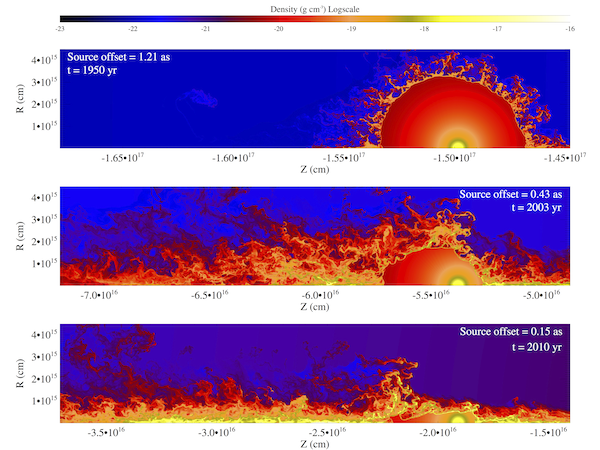G2 modelled as a mass-losing source of gas
by Alessandro Ballone
Recently, the discovery of the dense gas clump G2 (Gillessen et al. 2012, 2013) has caught the attention of the astronomical community. Observations in the L-band with the infrared imager NACO at the VLT have revealed a warm dust component, with a temperature of T dust ≈ 550 K, while the integral field spectrograph SINFONI allowed the detection of Brackett-γ, He I and Paschen-α line emission from an ionized gas (Tgas ≈ 104 K) component, with constant Brγ luminosity LBrγ ≈ 2 × 10-3 solar luminosities from 2004 to 2012. With the help of observations from the last 10 years, we have derived the dynamical properties of the object, finding that G2 is moving toward the SMBH of the Milky Way. It seems to follow a very eccentric orbit (e=0.97-0.98) with pericenter at a few thousand Schwarzschild radii, which G2 is expected to reach between late 2013 and early 2014. A big challenge is to explain the origin and nature of such a dense and low angular momentum object. Interestingly, Gillessen et al. (2012, 2013) find that the observed orbit of G2 roughly lies in the plane of the clockwise rotating disk of young and massive stars ranging from 0.04 pc to 0.5 pc around the central hot bubble. Hence, several authors have argued that the origin of G2 is related to this clockwise disk. Two scenarios have been suggested and investigated so far. In the first one, G2 is just a diffuse cloud formed along the current orbit. Through analytical considerations and detailed hydrodynamic simulations, Burkert et al. (2012), Schartmann et al. (2012) and Anninos et al. (2012) have investigated the origin and fate of such an object. The second scenario involves the presence of a compact and low luminosity source plunging toward SgrA*, which could have produced G2 via mass loss. First proposed by Murray-Clay & Loeb (2012) who suggested a photoevaporating protoplanetary disk, this scenario has also been put forward in different ways by Miralda-Escudé (2012), Meyer & Meyer-Hofmeister (2012) and Scoville & Burkert (2013). With the help of hydrodynamic simulations with the eulerian grid code PLUTO (Mignone et al., 2007, 2012), we have studied this latter "compact source scenario". We modeled spherically symmetric winds from a generic source on G2's orbit, following their evolution along their way toward the SMBH. We find that the interaction with the ambient medium and with the extreme gravitational field of the supermassive black hole in the Galactic Center play an important role in shaping these outflows. In particular, the thermal pressure of the hot and dense atmosphere of X-ray emitting gas in the Galactic Center confines the wind, while its ram pressure shapes it via stripping along the orbit, with the details depending on the wind parameters. Tidal forces squeeze the wind near pericenter, reducing it to a thin and elongated filament. We also find that in this scenario most of the Brγ luminosity is expected to come from the densest part of the wind, which has a highly filamentary structure with low filling factor. Keeping the mass-loss rate and velocity of the outflow as free parameters, we find that the observations can be best matched by a mass outflow rate of Mw = 8.8 × 10-8 solar masses per year and a wind velocity of vw = 50 km/s for our assumed atmosphere. The evolution of this "best" model is shown in the movie. The parameters we found are compatible with those of a young TTauri star wind, as already suggested by Scoville & Burkert (2013)."
Click on the image to see the movie!
low resolution version
high resolution version
